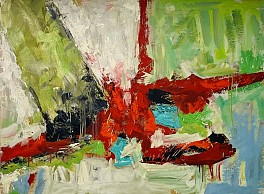BIOGRAPHY

American, 1920-1970
The history of the New York School painters is still being written, but Price earned a well-deserved place from the beginning. Price was one of the youngest of the first generation Abstract Expressionist circle of painters working in New York after WWII. Though only in his late twenties he began exhibiting in 1948 in New York at Hugo, Bodely, Iolas and Egan galleries. In a 1949, showing at Peridot galleries, Price was hailed for his breakthrough "Maze Series." A complex interweaving of organic shapes, automatic in nature and sometimes resembling bones or body parts, the "Maze" paintings exuded a pulsating energy that brought him critical acclaim. He received rave reviews in Art Digest, New York Times and New York Tribune.
Price's earliest work was biomorphic or surrealist in nature, influenced by the automatism of Andre Breton and his school. By 1946, his work began to move away from this style to an all-over, decentralized style which became the "Maze" works and ultimately AbEx works which saw their culmination in the "Black Warrior" series.
When the "Club" was started Price was invited to join and forged close relationships with other members of the New York School including Fritz Bultman, Giorgio Cavallon, Weldon Kees, Bradley Walker Tomlin, Robert Motherwell, Milton Resnick and Conrad Marca-Relli. In 1951 he was honored to be included in the 9th St. Show, the premier event of the Abstract Expressionist movement. He was close friends with Franz Kline throughout his life.
Price died young, at 50 in 1970. After his death Price was honored with retrospective exhibitions at the University of Alabama, the Speed Museum and the Corcoran Gallery. He is represented in numerous private and public collections including the Art Institute of Chicago, the Corcoran Museum of Art, the Los Angeles Museum County Museum of Art and the Milwaukee Art Museum.
